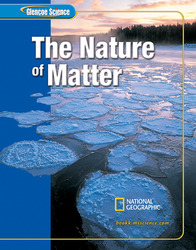 |
| 1.
|  | 
Some Greek philosophers believed that matter was made of __________.
|
|  | A) | molecules |
|  | B) | compounds |
|  | C) | elements |
|  | D) | atoms |
|
|
 |
| 2.
|  | 
A(n) __________ is a substance that cannot be broken down into simpler substances.
|
|  | A) | element |
|  | B) | mixture |
|  | C) | metal |
|  | D) | compound |
|
|
 |
| 3.
|  | 
What nineteenth century scientist combined the idea of elements with the Greek theory of the atom?
|
|  | A) | J.J. Thomson |
|  | B) | Ernest Rutherford |
|  | C) | Isaac Newton |
|  | D) | John Dalton |
|
|
 |
| 4.
|  | 
A piece of metal that can conduct electricity is called a(n) __________.
|
|  | A) | electron |
|  | B) | alpha particle |
|  | C) | foil |
|  | D) | electrode |
|
|
 |
| 5.
|  | 
How did J.J. Thomson know that the beam in the cathode-ray tube was not light?
|
|  | A) | It could not be seen without a microscope. |
|  | B) | The negatively charged particles in the beam were attracted to the negatively charged cathode. |
|  | C) | Light is not made up of particles. |
|  | D) | He used a magnet to bend the beam, and light cannot be bent by a magnet. |
|
|
 |
| 6.
|  | 
How did J.J. Thomson know that the particles in the cathode-ray tube were negatively charged?
|
|  | A) | These particles were attracted to the negatively charged cathode, and he knew that like charges attract each other. |
|  | B) | These particles were attracted to the positively charged anode, and he knew that opposite charges attract each other. |
|  | C) | The particles were spread evenly throughout the tube. |
|  | D) | Some of the particles went veering off at large angles to the tube. |
|
|
 |
| 7.
|  | 
The small, negatively charged particles discovered by J.J. Thomson are called __________.
|
|  | A) | electrons |
|  | B) | protons |
|  | C) | neutrons |
|  | D) | alpha particles |
|
|
 |
| 8.
|  | 
Which of the following best describes Thomson's model of the atom?
|
|  | A) | solid ball the same throughout |
|  | B) | small ball within a large shell containing empty space |
|  | C) | ball of raisin-cookie dough with raisins representing electrons |
|  | D) | electron cloud |
|
|
 |
| 9.
|  | 
Ernest Rutherford experimented with alpha particles and thin gold foil to find out __________.
|
|  | A) | the speed at which alpha particles travel |
|  | B) | Dalton's model of the atom was correct |
|  | C) | if Thomson's model of the atom was correct |
|  | D) | the size of the electron orbit |
|
|
 |
| 10.
|  | 
In Rutherford's experiment with alpha particles and gold foil, what was the function of the fluorescent film?
|
|  | A) | It was the electrode and conducted the negative charges through the foil. |
|  | B) | It flashed when hit by a charged particle and was used to track the motion of the alpha particles. |
|  | C) | It was the cathode and generated high-speed electrons. |
|  | D) | It was used to bend the stream of alpha particles. |
|
|
 |
| 11.
|  | 
Where did Rutherford propose that the positive charge in an atom was located?
|
|  | A) | in the outermost energy level |
|  | B) | spread evenly throughout |
|  | C) | moving in predictable orbits around the electrons |
|  | D) | in the center |
|
|
 |
| 12.
|  | 
What particle in an atom is electrically neutral?
|
|  | A) | proton |
|  | B) | neutron |
|  | C) | electron |
|  | D) | alpha particle |
|
|
 |
| 13.
|  | 
Which of the following models of the atom reflects the unpredictable motion of the electron?
|
|  | A) | solid ball the same throughout |
|  | B) | electron cloud |
|  | C) | small ball within a large shell containing empty space |
|  | D) | ball of raisin-cookie dough with raisins representing electrons |
|
|





